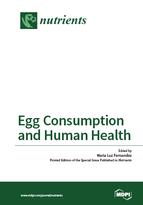Egg Consumption and Human Health
A special issue of Nutrients (ISSN 2072-6643).
Deadline for manuscript submissions: closed (31 July 2015) | Viewed by 199308
Special Issue Editor
Interests: lipoprotein metabolism; functional foods; eggs; metabolic syndrome; diabetes
Special Issues, Collections and Topics in MDPI journals
Special Issue Information
Dear Colleagues,
The purpose of this Special Issue, “Egg Consumption and Human Health,” is two-fold: 1) to address the lack of effect of eggs in increasing heart disease risk (this discussion will be based on what is known from epidemiological analysis and clinical interventions) and 2) to focus on the role of eggs in protecting against chronic disease. Eggs are more than just a cholesterol-containing food. They possess numerous nutritional benefits. This Special Issue will discuss eggs as a source of high-quality protein for individuals across the life spectrum, as a substantial source of choline (a known neurotransmitter involved in cognitive function), and as a source of highly bioavailable lutein and zeaxanthin (two carotenoids well-recognized for their major role in protecting against age-related macular degeneration and cataracts, as well as for their antioxidant and anti-inflammatory properties). Finally, the potential of incorporating eggs for weight loss interventions, due to their low glycemic index and their satiety effects, will also be discussed.
Professor Maria Luz Fernandez
Guest editor
Manuscript Submission Information
Manuscripts should be submitted online at www.mdpi.com by registering and logging in to this website. Once you are registered, click here to go to the submission form. Manuscripts can be submitted until the deadline. All submissions that pass pre-check are peer-reviewed. Accepted papers will be published continuously in the journal (as soon as accepted) and will be listed together on the special issue website. Research articles, review articles as well as short communications are invited. For planned papers, a title and short abstract (about 100 words) can be sent to the Editorial Office for announcement on this website.
Submitted manuscripts should not have been published previously, nor be under consideration for publication elsewhere (except conference proceedings papers). All manuscripts are thoroughly refereed through a single-blind peer-review process. A guide for authors and other relevant information for submission of manuscripts is available on the Instructions for Authors page. Nutrients is an international peer-reviewed open access semimonthly journal published by MDPI.
Please visit the Instructions for Authors page before submitting a manuscript. The Article Processing Charge (APC) for publication in this open access journal is 2900 CHF (Swiss Francs). Submitted papers should be well formatted and use good English. Authors may use MDPI's English editing service prior to publication or during author revisions.
Keywords
- dietary cholesterol
- LDL
- HDL
- healthy population
- populations at risk
- lutein
- zeaxanthin
- choline
- high quality protein
- appetite
- inflammation
- oxidative stress
- age-related macular degeneration







